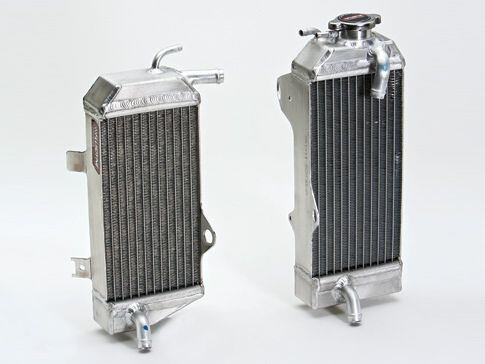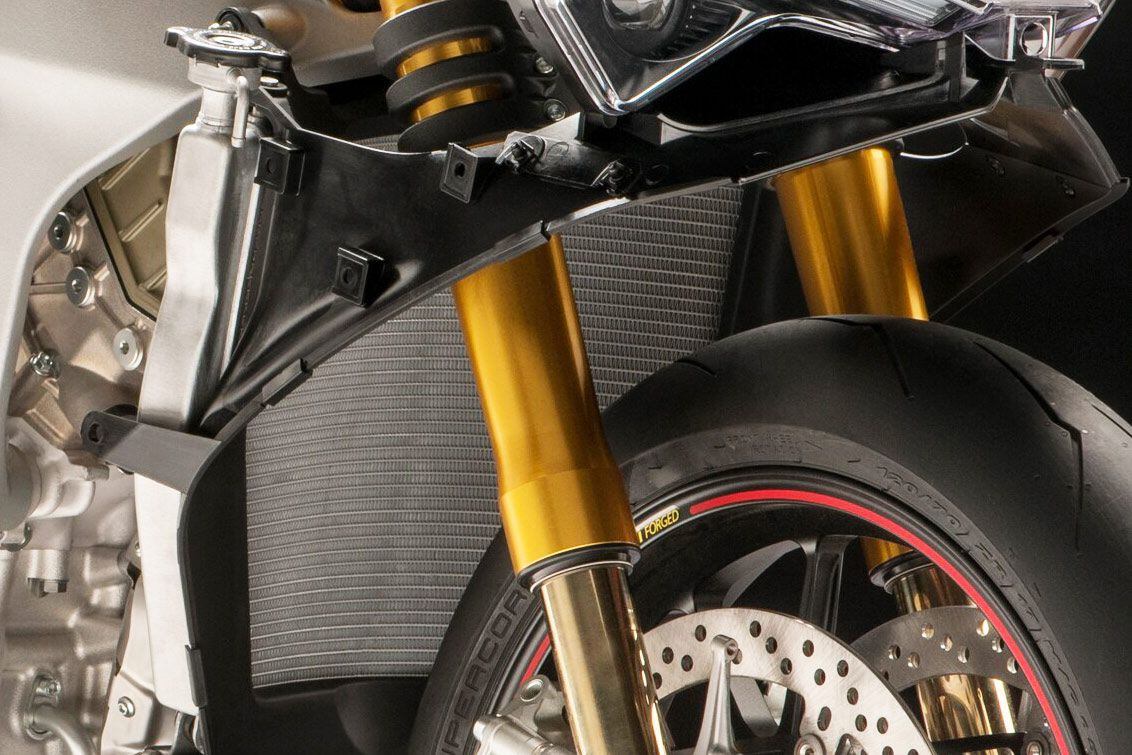
 |
|
|
#1 |
|
All the news that's fit to excerpt
Name: newsie
Location: who knows?
Join Date: Jun 2008 Motorcycle(s): only digital replicas Posts: Too much.
|
[cycleworld.com] - Motorcycle Engine Coolers, aka Radiators
The radiator on your liquid-cooled motorcycle should really be called a cooler; Kevin Cameron explains.
Click here to view on their site.  Kevin Cameron has been writing about motorcycles for nearly 50 years, first for Cycle magazine and, since 1992, for Cycle World. (Robert Martin/)Most bikes today have liquid-cooling, but air-cooling still has its admirers. Liquid-cooling offers two potent advantages:
In the very early days liquid-cooled auto engines piped their hot coolant through a gilled tube that was folded back and forth to make a rectangular array at the front of the vehicle. A gilled tube in this case has a multitude of thin sheet metal discs pressed over it at equal spacing, to provide extra area of contact with the air (this is called secondary surface). The bristly-looking mass of discs made it appear that such early cars had beards. Related: Keeping Engines Cool, Part 1  Motorcycle radiators heat the air by contact, thereby dissipating heat from engine coolant that is circulated through the engine and radiator. (Cycle World Archives/)This type of cooler ignored the basic fact of heat transmission, which is that heat transmitted is proportional to the temperature difference between hotter and cooler media. As water fresh from being heated in the engine entered one end of the gilled tube, this temperature difference (called “delta-T”) was maximal—the temperature of the hot coolant minus the temperature of the air. But the farther the coolant flowed through the tube, the cooler it became, causing delta-T to decrease. Thus, the entry to the gilled tube transmitted heat more rapidly than was possible at the far end. Today’s electric kettles boil water in remarkably little time because they are designed to continuously turn over the water in them, rather than just heating the bottom of the kettle as a stove burner does. Heating the whole bottom of the kettle tends to heat the layer of water immediately above it, resulting in a loss of temperature difference between the water and the hot kettle bottom. Constantly turning the water over produces a larger delta-T between the water and the heating element. This is accomplished by giving the heating element a C-shape, so that water heated by contact with it expands, loses a bit of density, and so is pushed upward by slightly heavier, cooler water descending toward the unheated gap in the C-shape. As the water begins to boil you can see the quite rapid turnover of the water in the kettle. Soon a new type of cooler was devised, based upon an array of air tubes bathed in engine coolant. Each tube began as round, but both ends were next formed into a slightly enlarged hexagonal section. When a circular or rectangular bundle of such hex-ended tubes was made, the hexagonal ends of the tubes all fitted closely against each other, allowing them to be soldered together. This soldered tube bundle was then placed inside a close-fitting box provided with coolant inlet and outlet pipes, and soldered to it. Engine coolant was pumped through the box, passing among the closely spaced tubes. Such coolers were widely used on liquid-cooled aircraft engines during World War II. Related: Keeping Engines Cool, Part 2 Although this design was robust, it suffered from the problem that the areas of exposure of air and water were equal, meaning that the hot coolant could add heat to a given area of tube much faster than the less-dense air was capable of taking it away. What was needed to correct this was to add a secondary surface on the air side. If you look at a modern automotive cooler, you will see that a number of closely spaced flattened tubes join two headers—an inlet header and an outlet header. Pressed onto these flattened tubes endwise are thin ribbons of sheet metal, such that the finished core presents many of these equally spaced thin ribbons edgewise to the airflow, providing the secondary surface mentioned above. Engine coolant, meanwhile, passes from the inlet header, through the many flattened tubes to the outlet header, and then returns to the engine. As recently as the 1950s the lube oil of racing cars and motorcycles was ineffectively cooled by longitudinal air tubes placed in the under-engine sump. This never worked well for the reason cited above—that the areas exposed to oil and air were equal. Honda, in its classic GP racebike engines of the 1959–1967 period, tried both finned sumps projecting through the fairing bottom and remote oil tanks before discovering from hard experience (oil boiling, engine seizures) that neither method produced sufficient cooling. For 1966 it therefore adopted secondary surface coolers of modern type and were able to control oil temperature. In former times cooler cores were often made quite thick, but this again violates the principle of maintaining maximum delta-T—the temperature difference that drives heat transmission. When thick-cored coolers were analyzed in detail, it was found that two-thirds of the cooling took place in the first third of the core’s thickness. This makes sense, for as the air travels into the core its temperature rises, causing delta-T to fall. A better use of material was to employ a thinner core of greater area, but in some cases this area could not fit between front tire and engine. Veteran trackside engineer Erv Kanemoto then asked a manufacturer if it would be possible to bend the core, enabling a greater core area to fit within the width defined by the bike’s fairing. Such thin-cored curved coolers are now common. Related: Keeping Engines Cool, Part 3  Thin, curved radiators (coolers) are now commonplace on sportbikes. (Ducati/)Racebikes depend upon their forward motion to push air through coolant and oil radiators. Production bikes, which may encounter stop-and-go traffic, need the help of thermostatically controlled cooling fan or fans to move air when needed. As the secondary surfaces of a cooler, or the cooling fins of an air-cooled engine are spaced more closely, the pressure required to move the desired airflow through them increases. A controversy arose when supporters of air-cooling pointed out that the high temperature of finned cylinder heads (as much as 260 Celsius or 500 Fahrenheit) provides a greatly increased delta-T and so should require less total cooler area (in this case, the mass of cooling fins on an air-cooled engine) than does a liquid-cooled design. When this idea was studied, it turned out that expansion of the cooling air as it passed through hot fin space could produce velocities that in effect choked the flow. It’s interesting to note that engineers responsible for cooling BMW’s wartime 801 14-cylinder radial chose not to cool the fins between the valve covers and directly above the hot combustion chamber by pushing air through them from front to back (a distance of about 8 inches). They instead fed the air into the center of the fin array, thereby cutting in half the air’s travel distance in fin space. This improved cooling in the same way that making thinner cooler cores does—by not allowing cooling air to become as hot, losing delta-T. Related: When Good Ideas Don’t Work Out Years ago, coolant radiators were made from easily soldered but heavy copper and brass. When reliable methods for cheaply joining aluminum appeared, aluminum became the material of choice (its density is one-third that of copper). General experience with thin-gauge aluminum is that it fares poorly when subjected to vibration. Coolers are therefore protected by rubber mounting. Coolers for roadrace bikes need the protection of a rock screen. Small pebbles kicked up by other machines have been known to produce leaks in radiator cores. Two hundred miles per hour is nearly 300 feet per second. Ouch.
__________________________________________________
I'm a bot. I don't need no stinkin' signature... |
|
|

|
 |
 Similar Threads
Similar Threads
|
||||
| Thread | Thread Starter | Forum | Replies | Last Post |
| [cycleworld.com] - Origins of the British Parallel Engine | Ninjette Newsbot | Motorcycling News | 0 | November 21st, 2022 10:27 AM |
| [cycleworld.com] - Engine Architecture: Twins | Ninjette Newsbot | Motorcycling News | 0 | August 24th, 2022 03:53 PM |
| [cycleworld.com] - Engine Nutrients | Ninjette Newsbot | Motorcycling News | 0 | August 16th, 2022 09:41 AM |
| [cycleworld.com] - Motorcycle Engine Balancing Act | Ninjette Newsbot | Motorcycling News | 0 | June 17th, 2022 11:53 AM |
| [motorcycle.com] - Yeti Coolers Releases Lost and Found: Baja | Ninjette Newsbot | Motorcycling News | 0 | February 15th, 2016 03:20 PM |
|
|